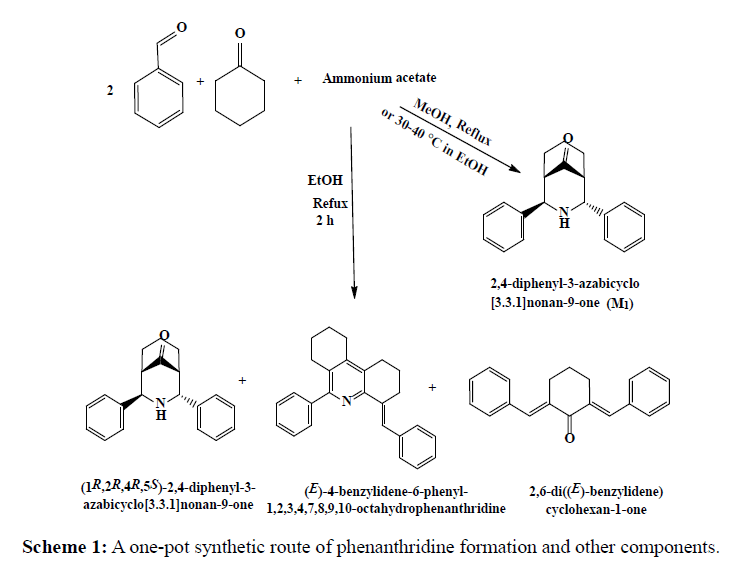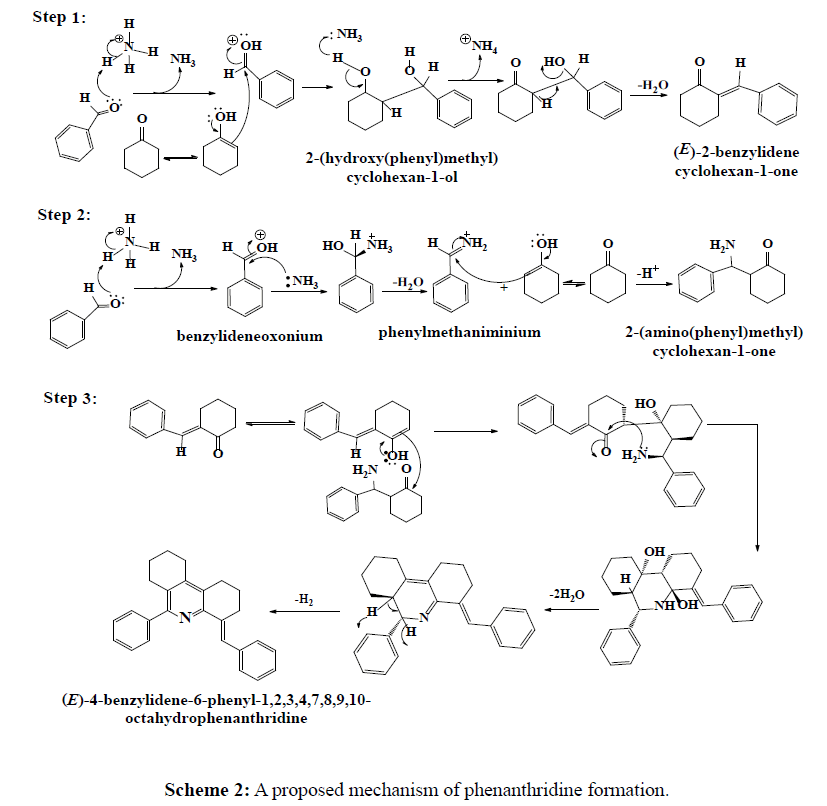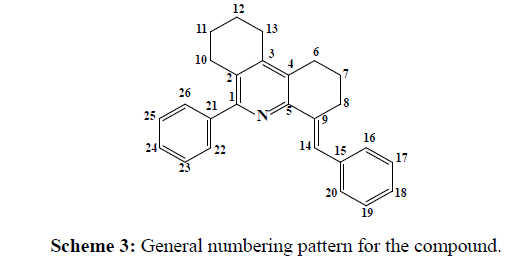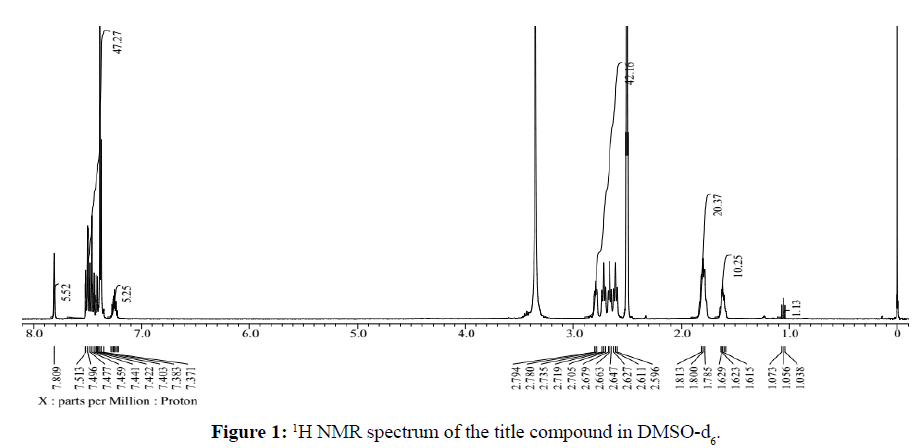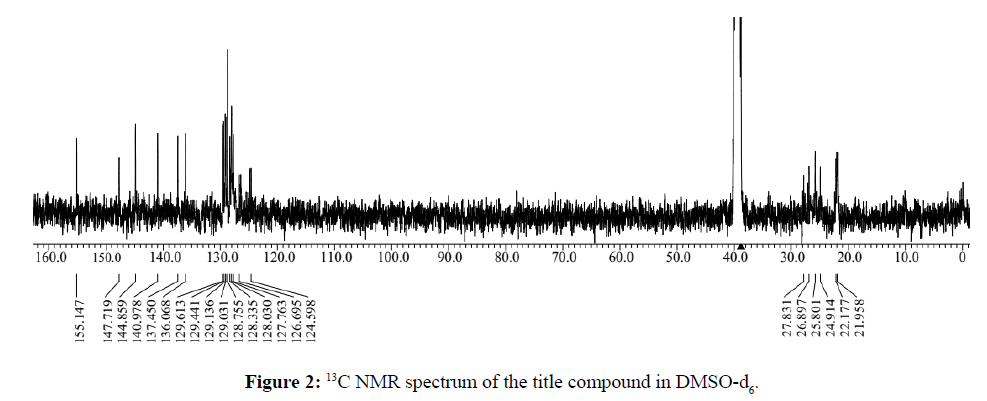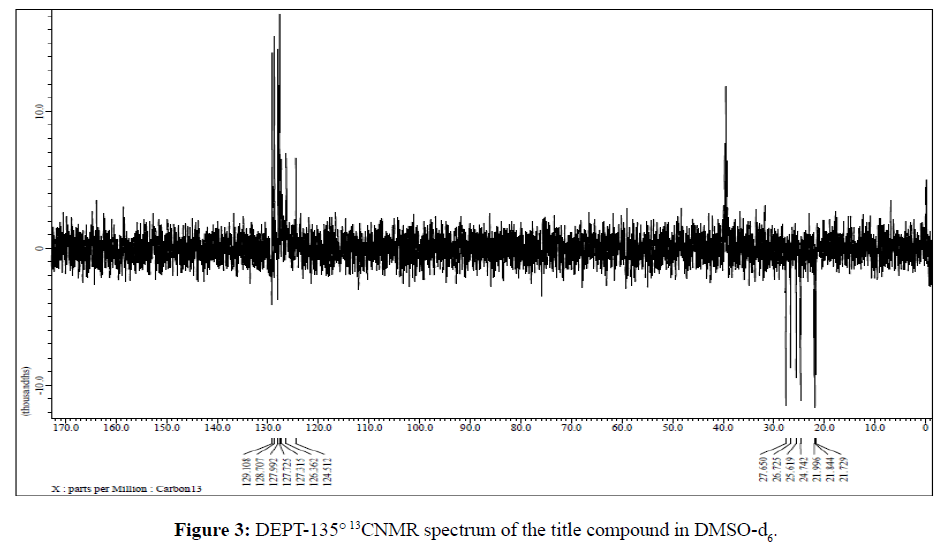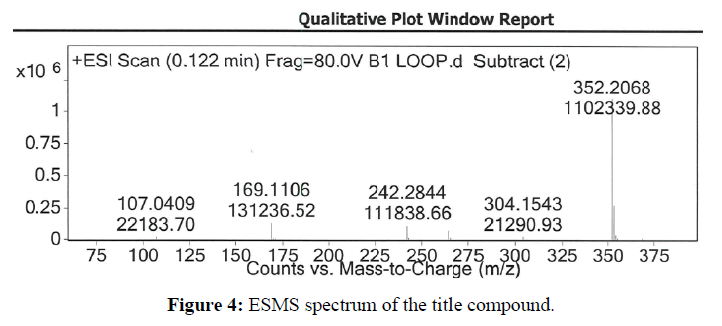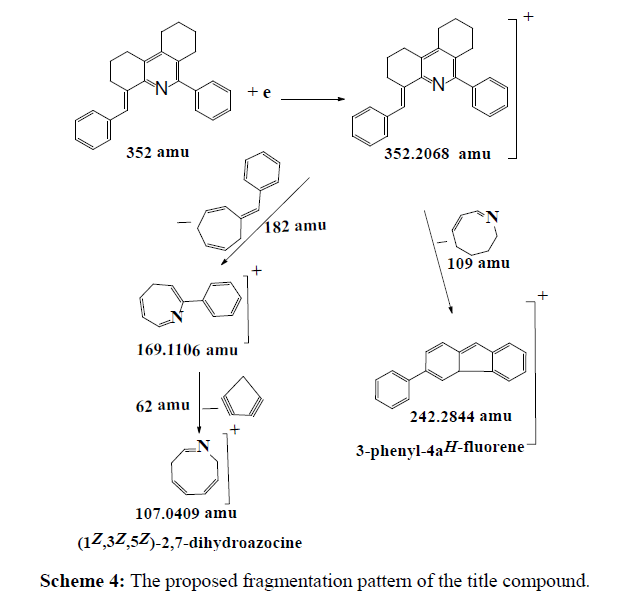ISSN : 0976-8505
Der Chemica Sinica
An Efficient One-Pot Approach for the Formation of Phenanthridine Derivative; Synthesis and Spectral Characterisation
Baidaa K Al-Rubaye1, Herman Potgieter2,3 and Mohamad J Al-Jeboori1*
1Department of Chemistry, College of Education for Pure Science (Ibn Al-Haitham), University of Baghdad, Iraq
2School of Research, Enterprise & Innovation, Manchester Metropolitan University, Chester Street M1 5GD, UK
3School of Chemical & Metallurgical Engineering, University of the Witwatersrand, Private Bag X3, Wits 2050, South Africa
Abstract
The preparation of the phenanthridine derivative compound was achieved by adopting an efficient one-pot synthetic approach. The condensation of an ethanolic mixture of benzaldehyde, cyclohexanone and ammonium acetate in a 2:1:1 mole ratio resulted in the formation of the title compound. Analytical and spectroscopic techniques were used to confirm the nature of the new compound. A mechanism for the formation of the phenanthridine moiety that is based on three steps has been suggested
Keywords
Phenanthridine moiety, One-pot reaction, Mannich reaction, Spectroscopic characterisation
Introduction
The formation of piperidine derivatives via the Mannich reaction is well known [1]. Further, the reaction of a ketone, with α-methylene groups, with an aldehyde in the presence of ammonium acetate afforded in the formation of the required piperidone derivatives through the Mannich reaction [2,3]. However, the isolation of the unexpected phenanthridine derivatives as a second product with the piperidone, upon using a range of cyclic ketones were also mentioned [2]. Phenanthridines, derivatives are an important class of heterocyclic nitrogen-based compounds that form a range of natural product and biologically important molecules that have found important applications in different fields [4]. Due to their potential applications in medicinal chemistry [5] and in the fabrication of materials [6], researchers have been interested to develop efficient and versatile methods for the synthesis of these compounds [7,8]. These compounds can be fabricated using a range of synthetic methods, including cyclisation that required harsh conditions and several preparation steps, to obtain phenanthridines [9]. Therefore, the need for a simple and straight forward approach to obtain phenanthridine derivatives is extremely required. In this paper, the formation of phenanthridine derivative was achieved via a one pot reaction using cyclohexanone and benzaldehyde in an ethanolic solution of ammonium acetate. Interestingly, the ammonium acetate plays the key role to facilitate the aldol condensation reaction and subsequently, the cyclisation process that yielded the title compound.
Materials and Methods
Experimental
General Notes: All reagents were commercially available and used without further purification. Solvents were distilled from appropriate drying agents according to standard protocols immediately prior to use. Elemental analyses (C, H, N) was carried out on a Heraeus instrument (Vario EL) and Euro EA 3000. Melting point was obtained on a Buchi SMP-20 capillary melting point apparatus and are uncorrected. The infrared spectrum was recorded as a KBr disc using a Shimadzu 8300s FT-IR spectrophotometer in the range 4000-400 cm-1. The mass spectrum was acquired by positive electrospray mass spectroscopy technique (ESMS) on a LTQ-FT mass spectrometer (Thermo Fisher Scientiï¬ÂÂc). NMR spectra (1H, 13C, DEPT-135°, 1H-1H COSY and HMQC NMR) were acquired in DMSO-d6 solutions using a JEOL-400MHz for 1H-NMR and 100.61 MHz for 13C-NMR with tetramethylsilane (TMS) as an internal reference for 1H NMR.
Synthesis
Synthesis of (E)-4-benzylidene-6-phenyl-1,2,3,4,7,8,9,10-octahydrophenanthridine: The title compound was isolated from the reaction mixture using flash column chromatography and as follows: A solution of benzaldehyde (4.02 mL, 0.038 mol), ammonium acetate (1 g, 0.019 mol) and cyclohexanone (2 mL, 0.019 mol) in ethanol (20 mL) was refluxed for 2 h. The obtained residue was purified from the crude product by flash chromatography with an eluent mixture (33% ethyl acetate / hexane), m.p=194-196°C. Yield: 42%. (IR, KBr) cm-1: 1600 ν (C=N), 1508 ν (C=C) aromatic ring. NMR data (ppm); 1H NMR, δH (400 MHz, DMSO-d6): 7.81 (s, 1H, H-14), 7.52-7.35 (m, 9H, Ar-H), 7.28-7.21 (m, 1H, Ar-H), 2.79 (t, 2H, H-13, J=10.4Hz), 2.71 (t, 2H, H-6, J=12Hz), 2.66 (t, 2H, H-10, J=12.8Hz), 2.61 (t, 2H, H-8, J=12.8Hz), 1.80 (m, 4H, H-11;12), 1.62 (m, 2H, H-7). 13C NMR, δc (100 MHz, DMSO-d6): 155.15 (C-1), 147.72 (C-5), 144.86 (C-3), 140.98 (C-9) and 137.45 (C-2), 136.07 (C-15), 129.61 (C-4), 129.44 (C-21), 129.14, 129.03, 128.76, 128.33, 128.00 and 127.76 and 126.70 (C-Ar), 124.60 (C-14), 27.83 C-8), 26.90 (C-6), 25.80 (C-10), 24.91 (C-13), 22.18 (C-11;12), 21.96 (C-7). The electrospray (+) mass spectrum showed the parent ion peak at m/z=352.2068 (M+H)+ for C26H26N; required=352.2065. Elemental analysis; Calc. for C26H25N: C 88.85, H 7.17, N 3.99%, found C 88.76, H 7.20, N 3.88.
Results and Discussion
Synthesis and Spectral Characterisation
Chemistry: The synthesis of (E)-4-benzylidene-6-phenyl-1,2,3,4,7,8,9,10-octahydrophenanthridine was based on a one-pot reaction of a mixture of benzaldehyde, cyclohexanone and ammonium acetate in a 2:1:1 mole ratio in an ethanolic medium under reflux. The use of EtOH under reflux gave a mixture of the title compound (E)-4-benzylidene-6- phenyl-1,2,3,4,7,8,9,10-octahydrophenanthridine, 2,4-diphenyl-3-azabicyclo[3.3.1]nonan-9-one and 2,6-di ((E)- benzyl idene)cyclohexan-1-one, which isolated using a flush column chromatography with an eluent mixture (33% ethyl acetate / hexane) that yielded 45, 42 and 13%, respectively (Scheme 1). The reaction is solvent and temperature dependent and upon using MeOH or heating the reaction mixture between 30-40°C, only the expected compound 2,4-diaryl-6,7-benzo-3-azabicyclo[3.3.1]nonan-9-one was isolated in almost quantitative yield. The title compound was isolated by column chromatography in a moderate yield and was characterised by a variety of physico-chemical methods.
A mechanism for the formation of the phenanthridine moiety that is based on three steps has been suggested (Scheme 2). The first step is based on the aldol condensation of the cyclohexanone that is facilitated by the benzaldehyde molecule and prompted by traces of acid to form the 2-(hydroxy(phenyl)methyl)cyclohexan-1-ol. The elimination of a water molecule gave the (E)-2-benzylidenecyclohexan-1-one molecule. The second step was related to the reaction of phenylmethaniminium, derived from the addition of NH3 to benzylideneoxonium, followed by the elimination of a water molecule, with cyclohexanone to give 2-(amino(phenyl)methyl)cyclohexan-1-one. The reaction of (E)-2-benzylidenecyclohexan-1-one with 2 (amino(phenyl)methyl)cyclohexan-1-one followed by ring closure, loss of 2H2O molecules and aromatisation by the loss of H2 affords the (E)-4-benzylidene-6- phenyl-1,2,3,4,7,8,9,10-octahydrophenanthridine.
FTIR and NMR Spectra
The FTIR spectrum of the compound exhibits characteristic bands at 1600 and 1508 cm-1 due to ν (C=N) and ν (C=C) of the aromatic ring, respectively. The assignments of peaks in the NMR spectra were made using DEPT-135° and 2D correlated spectroscopy. The numbering of these peaks were based on that reported in Scheme 3.
The 1H NMR spectrum of the title compound (Figure 1) in DMSO-d6 solution shows two characteristic sets of signals that are located in the aromatic and aliphatic regions. The signal detected at δ=7.81 (s, 1H) is attributed to H-14. This chemical shift appears as expected as a singlet. Peaks of the aromatic groups that equivalent to ten protons were detected as multiples at δ=7.52-7.35 (m, 9H, Ar-H) and 7.28-7.21 (m, 1H, Ar-H). The aliphatic region indicates two sets of chemical shifts. The first set showed the presence of four triplets, each of them equivalent to two protons) at δ=2.79 (t, 2H, H-13, J=10.4 Hz), 2.71 (t, 2H, H-6, J=12 Hz), 2.66 (t, 2H, H-10, J=12.8 Hz) and 2.61 (t, 2H, H-8, J=12.8 Hz). Moreover, the remaining six-protons of the methylene of the cyclohexyl segments appear as a multiple at δ=1.80 (m, 4H, H-11;12) and 1.62 (m, 2H, H-7). The analysis of the 13C NMR spectrum, Figure 2, with the support of the DEPT-135° result showed the presence of eight quaternary carbons at δ=155.15 (C-1), 147.72 (C-5), 144.86 (C-3), 140.98 (C-9) and 137.45 (C-2), 136.07 (C-15), 129.61 (C-4) and 129.44 (C-21). Furthermore, signals of the methylene groups of the cyclohexyl moieties at δ=27.83 C-8), 26.90 (C-6), 25.80 (C-10), 24.91 (C-13), 22.18 (C-11;12) and 21.96 (C-7) were enhanced in the negative direction in the DEPT-135° data (Figure 3).
Mass Spectroscopy
The positive ESIMS spectrum of the title compound gave an ion parent peak at m/z=352.2068 (M+H)+ for C26H26N; requires =352.2065, Figure 4. The proposed fragmentation pattern is outlined in Scheme 4, which suggests that there are two pathways for fragmentation. The first pathway gave the final species with an ion peak at m/z=242.2844 (M)+ for C19H14; required=242.1100. This fragment may indicate the formation of 3-phenyl-4aH-fluorene as the most stable species detected by the instrument. The second pathway showed several fragments, and the final species with an ion peak at m/z=107.0409 C7H9N; required=107.0735. This peak may be related to the (1Z,3Z,5Z)-2,7-dihydroazocine compound.
Conclusion
The title compound has been prepared through a one pot approach, which should greatly enhance it further utilisation in the areas mentioned in the introduction. The chemical has been deduced through the use of elemental analysis, NMR, MS and FT-IR techniques, which all complimented each other and confirmed the proposed geometrical arrangement in the molecule. A mechanism to explain the molecular formation of the title compound has been put forward to illustrate the reaction. This contribution should enhance and facilitate further work in this field.
Acknowledgement
The authors would like to thank the "Iraqi Ministry for Higher Education and Baghdad University" for the award of the PhD studentship to Ms Baidaa Al-Rubaye.
References
- Noller CR, Baliah V (1948) The preparation of some Piperidine Derivatives by the Mannich reaction. J Am Chem Soc 70: 853-3855.
- Karthikeyan NS, Sathiyanarayanan K, Aravindan PG (2009) Ammonium Acetate: An efficient reagent for the one-pot synthesis of 5-Aryl-7,8,13,14-tetrahydrodibenzo[a,i]phenanthridines, 2,4-Diaryl-6,7-benzo-3-azabicyclo[3.3.1] nonan-9-ones and α,α’-Bis(substituted benzylidene)cycloalkanones. Bull Korean Chem Soc 30: 2555-2558.
- Al-Jeboori MJ, Al-Fahdawi MS, Sameh AA (2009) New homoleptic metal complexes of Schiff bases derived from 2,4-di-p-tolyl-3-azabicyclo[3.3.1]nonan-9-one. J Coord Chem 62: 3853-3863.
- Tumir LM, Stojković RM, Piantanida I (2014) Come-back of phenanthridine and phenanthridinium derivatives in the 21st century. Beilstein J Org Chem 10: 2930-2954.
- Stevens N, O’Connor N, Vishwasrao H, Samaroo D, Kandel ER, et al. (2008) Two color RNA intercalating probe for Cell Imaging Applications. J Am Chem Soc 130: 7182-7183.
- Gerfaud T, Neuville L, Zhu J, (2009) Palladium-Catalyzed annulation of Acyloximes with Arynes (or Alkynes): Synthesis of Phenanthridines and Isoquinolines. Angew Chem Int Ed 48:572-577.
- Bao X, Yao W, Zhu Q, Xu Y (2014) Synthesis of 6-substituted Phenanthridine derivatives by Palladium-catalysed Domino Suzuki–Miyaura/Aza-Michael reactions. Eur J Org Chem 7443-7450.
- Xu Z, Yan C, Liu ZQ (2014) A Free-Radical cascade methylation/cyclization of N-Arylacrylamides and Isocyanides with Dicumyl Peroxide. Org Lett 16: 5670-5673.
- Herrera A, Alvarez RM, Chioua M, Chatt R, Chioua R, et al. (2006) The reaction of tetralones with nitriles: a simple approach to the synthesis of new substituted benzo[h]quinazolines, benzo[f]quinazolines and dibenzo[a,i]phenanthridines. Tetrahedron 62: 2799-2811.

Open Access Journals
- Aquaculture & Veterinary Science
- Chemistry & Chemical Sciences
- Clinical Sciences
- Engineering
- General Science
- Genetics & Molecular Biology
- Health Care & Nursing
- Immunology & Microbiology
- Materials Science
- Mathematics & Physics
- Medical Sciences
- Neurology & Psychiatry
- Oncology & Cancer Science
- Pharmaceutical Sciences
